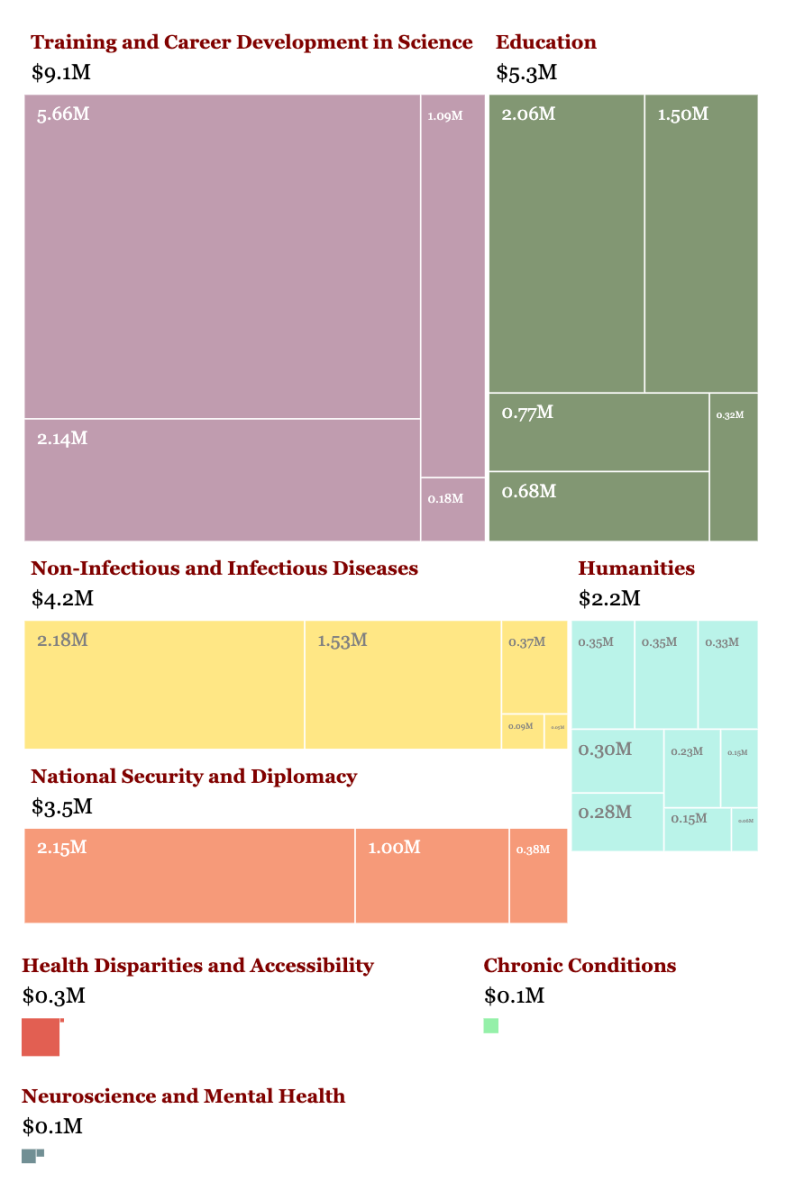In its fourth invite-only budget town hall, held April 21, the University presented a mixed picture of its financial situation, reemphasizing the progress it has made toward eliminating its substantial budget deficit in the past year while expressing concern over continued uncertainty tied to recent federal policy changes.
University Provost Katherine Baicker and Enterprise Chief Financial Officer Ivan Samstein presented the University’s updated financial outlook, reiterating that the operating deficit had narrowed from $288 million in fiscal year (FY) 2024 to $221 million for the current fiscal year. Still, Baicker and Samstein highlighted major challenges, including the termination of nearly 40 federal research grants and lower-than-expected tuition revenue, which currently sits $7 million below budget projections.
University President Paul Alivisatos opened the event by noting that recent changes in federal policy under the Trump administration could alter the University’s financial trajectory.
“This is a different kind of moment than previous budget town halls, so we will need to bring a different kind of spirit to the enormous challenges at hand,” Alivisatos said. “The present situation absolutely reflects a dramatically altered landscape from where we were in December.”
Since President Donald Trump took office in January, his administration has introduced a series of executive actions targeting federal research funding, discussed expanding taxes on endowments and philanthropic gifts, and signaled interest in revisiting the tax exempt status of universities.
Alivasatos emphasized the University’s commitment to its foundational values, including academic freedom and open debate. He noted that, although ongoing financial and policy volatility could constrain leadership’s ability to share detailed plans, the University is “ready to defend our values.”
The subsequent presentation shared a mixed picture of how key budget categories are tracking against expectations. According to presentation materials, the University’s projected net tuition revenue for FY2025 is $689 million—approximately $7 million below initial budget expectations.
Baicker described the deviation as “generally in range,” noting that core revenue sources are performing close to expectations despite broader economic headwinds. The University is currently seeing higher-than-expected costs in staff salaries and benefits (projected at about $7 million more than budgeted) and in supplies, services, and other expenses (projected at about $20 million more than budgeted).
The University’s revenue related to gifts and contributions is projected to exceed its FY2025 predictions by $43 million, surpassing the “record-setting” fundraising efforts from 2023 and 2024, according to presentation materials.
Baicker noted that, despite the University’s adherence to its plans to eliminate the deficit by FY2028, continued volatility related to federal research cuts “may push us off that trajectory.”
Enrollment remained stable over the past year, with the incoming Ph.D. cohort mirroring that of past years and enrollment in master’s programs meeting the budget projection, according to Baicker. The University also launched four new non-degree programs, which could generate new revenue from tuition-paying learners outside of traditional degree pathways.
Looking ahead, Baicker noted that spending moderation would continue to be necessary as the University seeks to close its deficit by 2028. While the University’s long-term plan focuses primarily on growing revenue, Baicker said that spending moderation is necessary in the short term because “spending moderation can happen more quickly than the revenue levers.”
“We spend most of our money—as we should—on our people,” Baicker said, highlighting that 29 percent of spending is allocated to staff salaries and an additional 12 percent towards benefits. However, non-personnel expenses (SSO, supplies, travel, equipment) are coming under review as part of a broader contingency planning effort.
Most of Baicker and Samstein’s presentation was devoted to discussing federal grant terminations, which had “some limited effect in this fiscal year, but [are forecasted to have] a more substantial effect for next year and the year going forward,” according to Baicker.
As of this month, nearly 40 federal research grants have been terminated with an expected aggregate impact of $10–15 million this fiscal year. That impact could grow to as much as $40 million during FY2026, Baicker said.
“We get new terminations weekly, so we expect that number to keep ticking up,” Baicker said. ”So that’s one of the areas where we really want to partner with the faculty and deans and the [research] teams to figure out how we help support researchers who are in the position of having their grant terminated.”
In addition to grant terminations, the National Institutes of Health (NIH) announced plans in February to slash negotiated rates for coverage of indirect research costs—expenses like administrative functions, building maintenance, utilities, and equipment—from 64 percent to 15 percent. According to Samstein, a cut of that size represents a potential annual loss of nearly $100 million for the University.
While a universal cut to the indirect cost rate is currently subject to a permanent injunction, the University is scheduled to enter its next routine renegotiation with the federal government for rates taking effect in July 2026.
The University’s annual federal grant portfolio sits at approximately $550 million, half of which comes from the NIH, according to presentation materials. “We are fortunate in that we have a pretty diverse revenue base,” Baicker said. “There are peer institutions where this grant number is a much more concentrated percentage of their numbers of their revenue base.”
The University’s FY2026 budget—which Baicker and Samstein added is typically finalized by this point in the year—also remains in flux as a result of the evolving federal situation. “We are having to be a little more flexible and take as much time as we can to be able to have as much information as we can before inking a plan for the coming year,” Baicker said.
Other potential threats to the University’s long-term financial goals include the possibility of the loss of its tax-exempt status or an increase in taxation on its endowment. After Harvard University stated that it would not comply with federal efforts to undermine its independence, Trump wrote on Truth Social that “Perhaps Harvard should lose its Tax Exempt Status and be Taxed as a Political Entity.”
Samstein stressed that the loss of UChicago’s tax-exempt status is “lower on the spectrum” of his concerns. The endowment tax is placed on net investment income, which would not correspond to significant weight in the short to medium term. However, he noted that each 1 percent increase in the endowment tax rate correlates to an approximate $10 million loss in revenue for the University.
Any increase in the endowment tax rate would more likely come from a congressionally approved bill, rather than an executive action, Samstein said. One proposal, introduced by Representative Troy Nehls (R-Texas) in January, would raise the endowment tax rate from its current 1.4 percent to 21 percent.
The endowment also faces pressure from stock market volatility in the wake of Trump’s tariff plans, but, as Samstein joked, “the good news is the stock market can’t drop at 5 percent a day, every day, forever.”
Baicker and Samstein also addressed uncertainties around Medicaid and federal healthcare policy, with potential implications for the University of Chicago Medical Center (UCMed).
“Our hospital here in Hyde Park is the largest Medicaid provider in the Midwest, of any single-site hospital,” Samstein said. “We are quite concerned about what might happen and what transpires in Medicaid.”
One particular area of concern is the federal 340B Drug Pricing Program, which provides discounted pharmaceuticals to hospitals serving a large Medicaid population. Changes to the program—along with broader cuts or restructuring of Medicaid—could significantly alter UCMed operations. Although no concrete proposals have been introduced, Baicker warned that such reforms would likely appear in a future federal budget reconciliation bill and are “something we’ll need to monitor.”
Going forward, Baicker said the University hopes to broaden its funding base by pursuing partnerships with foundations, nonprofits, and industry, which is part of a larger effort to identify external support that can help research institutions reconfigure their portfolios as traditional federal grants are withdrawn.
The University also plans to expand global and hybrid education platforms to support international students, whose visa eligibility and status in the U.S. remain uncertain due to shifting immigration policy; two weeks ago, seven UChicago affiliates had their visas revoked by the U.S. Department of State without explanation.
“This has to be an iterative, collaborative endeavor, and we’re in the middle of it, and we’re going to be in the middle of it for a long time, so we will commit to coming back regularly with more information,” Baicker said. “But it’s really important to share this information as it evolves, because the answers to a lot of these questions are going to be different next week from what they are right now.”










Grabiel Kaermer / Apr 26, 2025 at 1:17 am
While there is supposedly some good news to be found, I for one would appreciate more transparency and democracy in the budgetary process; I concur with Clifford. I love democracy.
Clifford Ando / Apr 24, 2025 at 9:08 am
This is the second town hall in which the University’s leadership has said that fundraising hit record levels in ’23 and ’24. I write to express some skepticism about this, at least as regards the University separate from the Medical Center and MBL.
In the published financial statements, “private gifts and grants restricted for long-term investment” was $276 million in ’23 and $244 million in ’24. That compares with: $313 million in ’16, $328 million in ’17, $239 million in ’18, $996 million in ’19, $287 million in ’20, $350 million in ’21, and $331 million in ’22. In other words, the last two years were worse than every year but one since 2016.
Of course, a single figure from the financial statements doesn’t capture the full story; one could combine measures of private gifts in the categories of temporarily and permanently restricted assets, and it is likely that there are other and probably better ways to do this.
Whether the leadership’s characterization of its own success is accurate will depend on someone’s offering a full account of the figure they are using and a tabulation of the numbers from the financial statements.